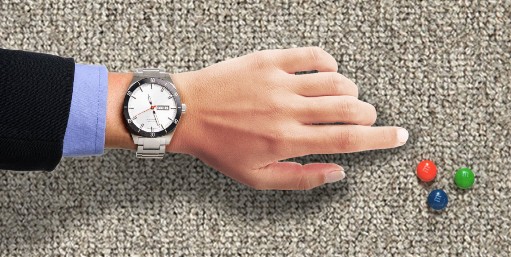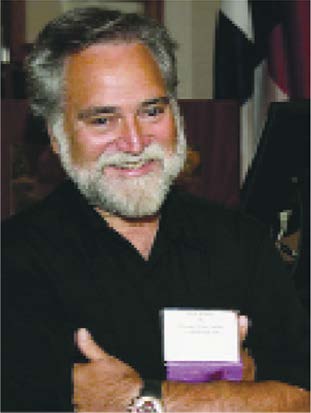ANCORA IMPARO
RICK RADER, MD ■ EDITOR-IN-CHIEF
The 10-Second Rule
The 10-Second Rule While The 10-Second Rule may be of interest to the "foodies" among us, my editorials are dedicated to addressing issues of keen interest (most notably regarding healthcare) to the disability community and so I want to introduce you to the 18-Second Rule.
Sitting at my desk early this morning, I spot a small yellow stickie note attached to my computer screen. Despite the fact that computer programs have the ability to alert me of upcoming deadlines, including blasting John Philip Souza's marching band musical alerts, I still use yellow stickie notes to remind me of impending doom. And yes, I do answer to "dinosaur," "luddite," "cave dweller" and "uneducable."
The stickie reminds me that my next Exceptional Parent magazine editorial (this one) is due tomorrow. So I dutifully remove the stickie and clear my desk in preparation for the creative juices to begin to percolate.
This is a great opportunity to try something new. My colleague here at Orange Grove, Patti Wade, gifted me a bag of M&M's. As you know, M&M's come in two basic flavors, traditional chocolate and the peanut M&M' s. Recently , M&M's have gone ballistic and have been coming out with new fla vors. Most recently they were field-testing Thai Coconut Peanut, English Toffee Peanut, Toffee Peanut, and Mexican Jalapeno Peanut. Of the three new flavors, only one will prevail. It's part of their marketing strategy where the public will decide on the winner.
And speaking of chocolate, reporter John Hufner recently published this warning: "Rising temperatures from climate change threaten to shrink the slim strip of rainforests around the equator where the cacao trees used to make chocolate thrive, according to a 2016 review from the National Oceanic and Atmospheric Administration (NOAA). And the two West African nations that produce over half of the world's chocolate – Ghana and Ivory Coast – would feel the heat." So, there may be a major world chocolate shortage by 2050. According to longevity statistics, I will be spared living in a world without chocolate as I would be 102 years old in 2050.

TEN, NINE, EIGHT... : I pour the the M&M's into a Styrofoam coffee cup to set beside my keyboard. I figure every time I complete a paragraph I would reward myself with an M&M. Just as I knock off my fourth paragraph, two of the M&M's get knocked out of the cup and hit the ground. I stare at them laying comfortably on the carpet and immediately recall The 10-Second Rule.
Patti's gift of a new M&M treat (caramel) is most welcome and anticipated. So I open the bag and pour the little critters into a Styrofoam coffee cup to set beside my keyboard. I figure every time I com plete a paragraph I would reward myself with an M&M. All goes well for the first three paragraphs.
I knock off paragraph four and reach for my reward (by this time I am starting to feel like a lab rat from a behavioral experiment) but this time two of the M&M's get knocked out of the cup and hit the ground. I stare at them laying comfortably on the carpet and immediately recall The 10-Second Rule. The 10-Second Rule (sometimes also referenced as The Five-Second Rule) is a long- standing food hygiene myth that states that "there is a defined window where it is permissible to pick up food after it has been dropped and thus exposed to contamination." While this has been cited as amusing social fiction, it is amazing how many people actually employ this and opt for rescuing the fallen food and eating it.
While this may be of interest to the "foodies" among us, my editorials are dedicated to addressing issues of keen interest (most notably regarding healthcare) to the disability community and so I want to introduce you to the 18-Second Rule.
While medical school begins with the dissection of a cadaver, I think it's equally important to dissect the "patient-physician" encounter (which is currently referred to as the "patient experience"). Historically, the patient is presented to the physician to discuss a health related problem. This begins the initial phase of the "intake." It is during this phase that the patient is invited to discuss and describe "what has happened to them" and why have they come to see the physician.
In 1984, writing in the journal Annals of Internal Medicine, researchers Beckman and Frankel ascertained that it takes a physician only 18 seconds to interrupt a patient after they invite the patient to describe their symptoms. This is now known as the "18-Second Rule." Beckman and Frankel concluded, "Physicians play an active role in regulating the quantity of information elicited at the beginning of the clinical encounter, and used closed-ended questioning to control the discourse. The consequence of this controlled style is the premature interruption of patients, resulting in the potential loss of relevant information."
At the heart of The 18-Second Rule is something called floccinaucinihilipilification. Physicians are well-schooled in its employment.
Floccinaucinihilipilification is seeing something as unimportant or worthless; and it plays a part in every patient encounter. In the nanosecond a physician begins to think that the information provided by the patient is unimportant or insignificant, the "interruption" is believed to be warranted. In today's current medical practice, climate time is omnipotent. It is the core of the business model in providing medical care. It provides the scaffold for the 14-Minute Rule, which requires the practitioner to see the patient, interview the patient, review the chart, check the lab and imaging results, examine the patient, diagnose the condition, create a treatment plan and provide a medication and follow-up plan… in 14 minutes.
So, of course, you can only provide the patient with 18 seconds to plead their case. In interacting with patients with intellectual and developmental disabilities, you can expect it will take longer than 18 seconds to listen (not just hear) to their concerns. It will probably take longer than that just to allow them to settle down into what is often a strange, uncomfortable and anxiety-producing environment. I believe it will probably take the physician at least 18 seconds, or more, to clear their heads from the typical patient encounter and to reorganize their thinking to this most challenging and rewarding group of patients.
It behooves the physician, the truly engaged, empathetic and sensitive physician, to drop both The 18-Second Rule and The 14-Minute Rule and adopt The One Patient Rule – the one that states that the patient, the one in front of you, deserves the respect, dignity and compassion that this One Patient deserves. Out of respect for the 10-Second Rule and with three seconds to spare, I picked up the two grounded M&M's and popped them in my mouth. After all it's The Rule. •

ANCORA IMPARO In his 87th year, the artist Michelangelo (1475 -1564) is believed to have said "Ancora imparo" (I am still learning). Hence, the name for my monthly observations and comments. – Rick Rader, MD, Editor-in-Chief, EP Magazine Director, Morton J. Kent Habilitation Center Orange Grove Center, Chattanooga, TN